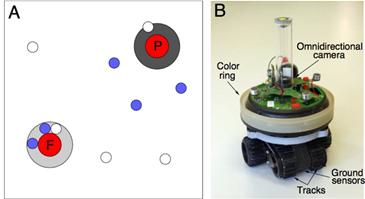
By David Ponce
Robots are now learning how to lie. Here’s how it happened. Researchers at the Ecole Polytechnique Fédérale de Lausanne setup an experiment with a bunch of autonomous bots. They programmed them to look for food (a light colored ring on the floor) and avoid poison (a dark ring). The bots also had a blue light that could be detected by the other bots. The longer the bots stayed around the food, the more points they got. Since space was limited, bots would jostle around the food while simultaneously creating a cluster of blue lights that could serve as a beacon for other bots that food had been found.
The researchers then introduced “evolution” into the experiment by “by copying and combining the artificial neural networks of the most successful robots. The scientists also added a few random changes to their code to mimic biological mutations.” By the 50th generation the found that robots were flashing their blue lights less and less when they found food. A few hundred generations later and hardly any robots flashed their lights once they had found the food, thereby increasing their chances of getting more points while concealing their find to their neighbors.
The slimy bastards.
Researchers concluded this study may help them better understand the evolution of biological communication systems.
[ Upcoming Study Abstract ] VIA [ Technology Review ]










